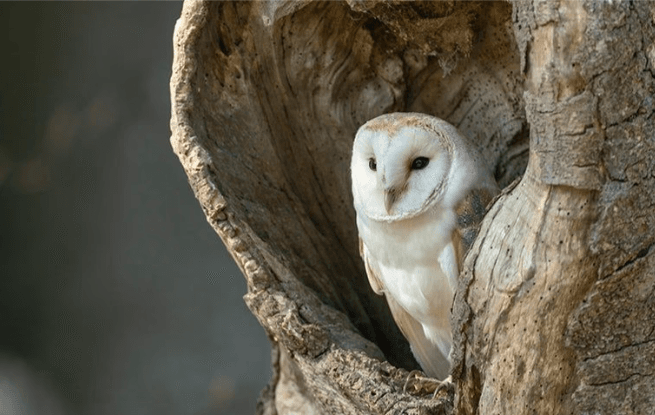
Barn Owls in North America: Your Natural Rodent Control Solution

A single barn owl can consume about 1,500 rats, mice, voles and gophers per year. A family of barn owls can consume 25 rodents per night. As a result, the U.S. Fish and Wildlife Service determined that the barn owl is one of the most economically beneficial wildlife species in North America.
Barn owls produce a large number of offspring compared to other owls. Most species of birds produce only one clutch of eggs per year. Barn owls can have up to three clutches per year, and they lay 4 – 10 eggs per clutch. Because they are raising one clutch after another and have so many hungry mouths to feed, they provide excellent, year-round rodent control.
In some parts of its range the barn owl is gravely threatened, including parts of the Midwest and eastern United States. The barn owl requires a tree cavity or old building in order to raise a family. Owl boxes can be effective in increasing the number of much-needed nesting sites.
Owls swallow most of their prey whole, and approximately 12 hours later they regurgitate a pellet consisting of the bones and fur of their last meal. These pellets, when deposited in the nesting area, create a soft carpet upon which to lay the eggs. They also provide researchers with a clear picture of what the owls are eating. From the study of barn owls and their pellets, it is known that these owls are amazing consumers of rodents and thus extremely beneficial to the environment. Rodents, such as rats, mice, voles and gophers, are their preferred food.
Barn owls have the best hearing of any animal tested. All barn owls have a disk-shaped face that resembles a heart. This disk is not decorative—it performs an important function. The owl’s ears are placed asymmetrically on the sides of its head. The disk around the face helps to funnel sound into the owl’s ears and allows it to zero in on the exact location of prey – even in total darkness. Barn owls are capable of locating and capturing prey solely by sound, although they also have excellent night vision. This “satellite dish” on the barn owl’s face is so important it has a unique accessory that no other owl has: a special “comb” on one toe of each foot, which is used to comb the disk and keep it in good shape.
Enhance Your Property with Barn Owl Nest Boxes
Unfortunately, every year in the United States, thousands of owls and hawks die as a result of eating poisoned rats. The widespread use of rat poison is killing off our best natural rodent exterminators. You can be part of the solution to this problem. Instead of using rat poison, install a nest box on your property. This will help naturally resolve your rat problem and at the same time provide a much-needed nest site for barn owls. Unlike great horned owls, barn owls are not a threat to cats or dogs. Barn owls are much smaller than great horned owls. There are nest boxes specifically designed to exclude great horned owls.
Recent Blog Articles
Our Tips & Tricks
-
 Raccoon Latrines: What Homeowners Need to KnowRead More
Raccoon Latrines: What Homeowners Need to KnowRead More -
 How To Stop Birds From Entering Your House This WinterRead More
How To Stop Birds From Entering Your House This WinterRead More -
 How to Winterize Your Texas Home and Prevent PestsRead More
How to Winterize Your Texas Home and Prevent PestsRead More -
 How to Identify Wildlife Presence in Your HomeRead More
How to Identify Wildlife Presence in Your HomeRead More -
 Why Rodent Sightings Always Go Up During the WinterRead More
Why Rodent Sightings Always Go Up During the WinterRead More -
 How Local Wildlife Reacts During Houston & DFW HeatwavesRead More
How Local Wildlife Reacts During Houston & DFW HeatwavesRead More -
 The Importance of Humane Wildlife ControlRead More
The Importance of Humane Wildlife ControlRead More -
 Summer Wildlife Problems In TexasRead More
Summer Wildlife Problems In TexasRead More
.2512181415325.jpg)

.2510130826253.jpg)











